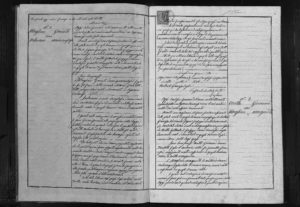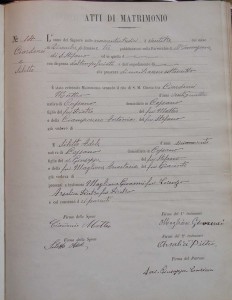About ten years ago I made a huge break though in researching my paternal Italian ancestors. At a meeting of my local genealogy society, Marin County Genealogical Society, I learned to search place names at FamilySearch. This simple search resulted in ordering the microfilm of records for the Catholic Parish in Cossano Canavese, Turino, Piedmonte, Italy. I was absolutely ecstatic to find records leading me back to the mid 1800’s and generations of ancestors.
I learned some basic Italian including numbers, months, and genealogy terms. I also ordered a book about Italian records to help understand what the form records for baptisms, marriages, and deaths meant. At the time I stopped my research at 1838. Why this specific year? This was the first year the forms were used. Before 1838, the records are handwritten in mostly Latin but also using a Latin/Italian mix and abbreviations I did not understand. The microfilm also had confirmation records at the end of the film. At the time I did not have the confidence or knowledge to figure out the confirmation records.
Fast forward to Covid-19 pandemic life. Thankfully years ago FamilySearch made the decision to digitize their collection. This has been a lifesaver for research during our new stay at home lifestyle. A DNA match led me to revisit the Cossano Canavese records. Due to endogamy in the small town my ancestors are from I was unable to figure out the connection.
With more experience under my belt I decided to take a look at the Confirmation records since I was already looking at the image. To my surprise there was more than confirmation records but also information that appeared to be census records!!

I went through the entire section and made myself a table of contents for the images. I realized along with confirmation records, mixed in, there was a census record for the years 1768, 1772, 1802, 1807, 1813, 1820 (partial), 1822, 1825, and 1870! To my amazement these church census records included who was in each household, birthdates, death dates (if within a few years of the census), relationships, and maiden names.
After confirming I could find my family in these records, I was able to add two more generations to my paternal line by working my way back through the census records.

I pulled out my Italian Records book again to get help translating Latin words in the earlier enumerations. While reviewing the information about parish records, I found a section called Status Animarum Records.
Status Animarum translates to “state of the souls”. It was a census list taken by the church for tax purposes. Once again history matters! Per Wikipedia, “The Papal States, officially the State of the Church, were a series of territories in the Italian Peninsula under the direct sovereign rule of the pope from the 8th century until 1870. They were among the major states of Italy from roughly the 8th century until the Kingdom of Piedmont-Sardinia unified the Italian Peninsula by conquest in a campaign virtually concluded in 1861 and definitively in 1870. ” This means the clergy at the local parish were also the civil authorities and in charge of collecting taxes for the number of working males in each household.

I made a plan to focus on one branch at a time. I also stopped to learn more about records written in Latin. This was an important decision so I could start using the handwritten records. I combined the census records with the early baptism, marriage, and death records. I have added 2-4 generations on each line of my Italian ancestors taking me back to the late 1600’s and early 1700’s. I added all of the images to each person on FamilySearch.

I am over the moon happy about my progress. There are so many records, I have worked on this specific project for over 2 months. I plan on sharing some of the records, I have found in the coming weeks. There are really interesting stories you can decipher from these records.



















